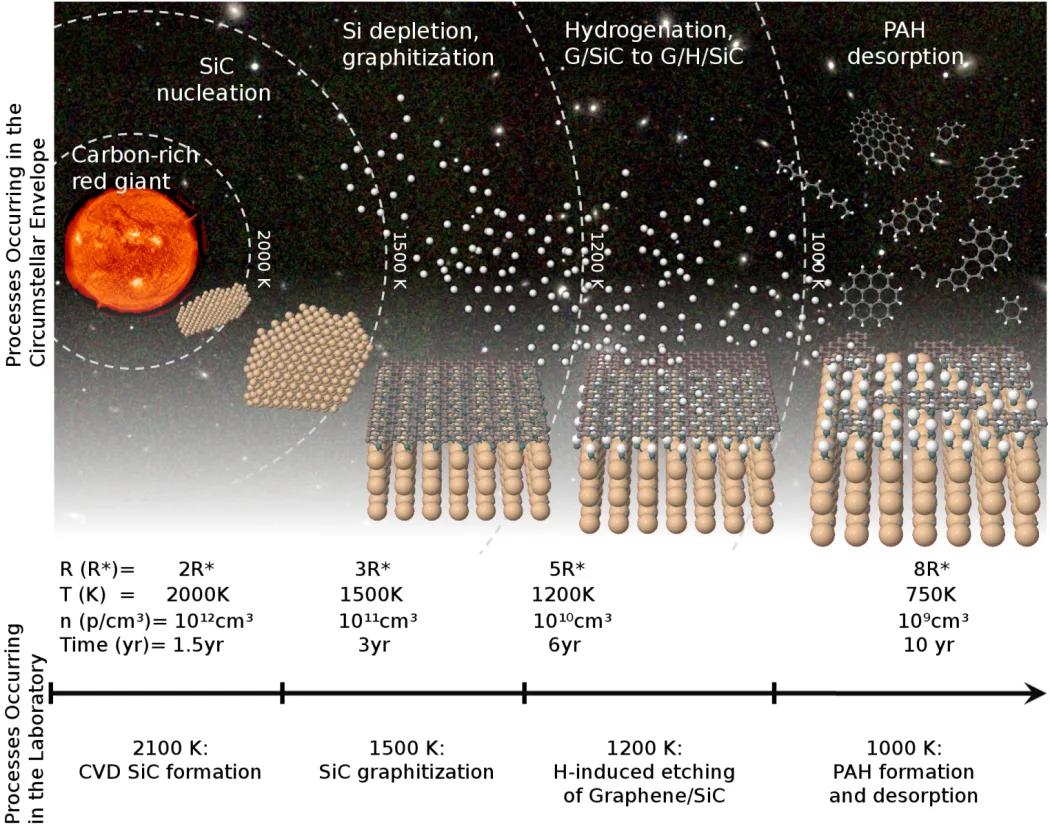Scientists from the Institute of Physics of the ASCR, together with colleagues from Spain and France presented in the journal Nature Communications new theory of the origin of polyaromatic hydrocarbon molecules in the universe. According to the new theory, these molecules are formed by hydrogen etching of the graphitic surface of the stardust particles.
Measurements made using large radio telescopes show the presence of large amounts of polyaromatic hydrocarbons – i.e. the molecules composed of carbon and hydrogen with two or more benzene rings – in the vicinity of some stars. These organic molecules are key to understanding the origin of life in the universe, but their origin is still unclear. Current theories of these compounds are based on the assumption of bottom-up chemical processes, where there is a merging of small molecules in larger units as a result of mutual collisions. However, this method cannot satisfactorily explain the large amount of these hydrocarbons in interstellar space. The new theory presented in the latest issue of Nature Communications is based on completely opposite principle. The polyaromatic hydrocarbons form in interstellar space via atomic hydrogen adsorption on graphite layers covering the surface of the particles of stardust, subsequent decomposition of graphene and final release of polyaromatic molecules (see Fig. 1).
As already happened in science many times, experimental observations in one discipline – in this case the physics of surfaces – can bring a whole new findings in a seemingly unrelated field like astronomy. The new theory of the origin of polyaromatic hydrocarbons was originated by experiments carried out using scanning tunneling microscope at the Institute of Physics ASCR, which studied interaction of atomic hydrogen with the graphene grown on silicon carbide in conditions similar to those in the interstellar medium (i.e. ultra high vacuum and high temperature). Observation of the surface of the graphene after being exposed to a flux of atomic hydrogen and at a temperature of about 800 °C, revealed a significant subsidization of graphene layer accompanied by formation of graphene flakes passivated by hydrogen. These graphene flakes can be considered germs of polyaromatic hydrocarbons. Based on these and other experimental observations, which were further supported by theoretical calculations showing the decomposition of graphene with hydrogen at high temperatures, we proposed a new theory of the formation of polyaromatic hydrocarbons (see Fig. 1) in interstellar space.
A new theory of the origin of aromatic hydrocarbons in the Space helps to answer one of the fundamental questions of astrochemistry and opens new possibilities for understanding the origin of life in the Universe. The editors of the journal Nature Communications selected the paper as the highlight of the recent issue of the journal.
P. Merino, M. Švec, J. I. Martinez, P. Jelínek, P. Lacovig, M. Dalmiglio, S. Lizzit, P. Soukiassian, J. Cernicharo, J. A. Martin-Gago, ‘Graphene etching on SiC grains as a path to interstellar polycyclic aromatic hydrocarbons formation’ Nature Communications (2014)
DOI: 10.1038/ncomms4054
Contact:
Martin Švec
Tel.: +420 220 318 302
E-mail: svec [at] fzu [dot] cz (svec[at]fzu[dot]cz)
Pavel Jelínek
Tel.: +420 220 318 430
E-mail: jelinekp [at] fzu [dot] cz (jelinekp[at]fzu[dot]cz)
Address: Cukrovarnická 10, CZ-16200 Praha 6
